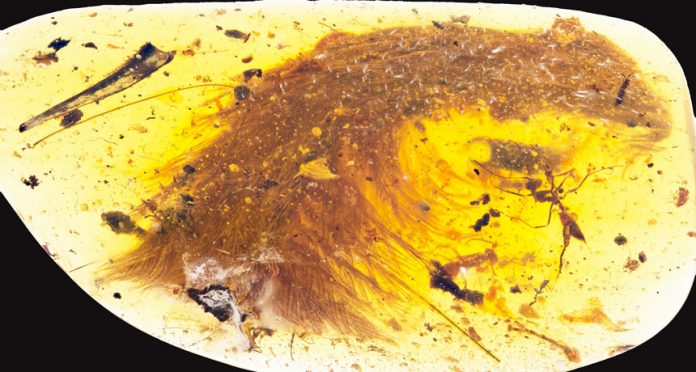For the first time, scientists have got their hands on the tail of a non-avian feathered dinosaur preserved inside a piece of amber for almost 100 million years.
Unlike dinosaur fossils found in sedimentary rock layers, this little beauty isn’t squished flat, which allows paleontologists to study the tail as it was in life. Another bonus: the amber appears to have preserved components usually lost to the ages, including what may be residual iron from red blood cells.
The 1.4-inch tail, described in a paper published in the journal Current Biology, is part of a treasure trove of fossils that paleontologist Lida Xing from the China University of Geosciences discovered last year at an amber market in Myanmar, in Southeast Asia. The tail most likely belongs to a tiny feathered dino that was no bigger than a sparrow. The tail is so small that it suggests the dinosaur was a juvenile; the animal likely died in northwest Myanmar before tree resin encased its tail.
This isn’t the first clue about dinosaurs’ feathers. After all, birds evolved from tiny, meat-eating dinosaurs called theropods. Fossilized imprints suggested dinosaurs had feathers during the cretaceous period, between 145 to 65 million years ago. Single feathers had also been found in amber, but without the bones, no one could conclusively say the feathers were dinosaur and not ancient bird.
This fossil, though, is the first time a well-preserved dinosaur was found in amber. The amber preserved the animal’s bones, soft tissues, and its feathers, which gives scientists an unprecedented glimpse at how dinosaur feathers developed.
“You get really fine preservation, because it’s in amber and it’s in 3D,” says Pete Makovicky, a curator of dinosaurs at the Field Museum of Natural History who was not involved in the research. “That gives an ability to really understand these structures, both in extreme detail and also in three dimensions.”
The researchers analyzed the tail with microscopes and CT scans, and found out that the feathers spread out sideways from the tail like a frond. They were probably dark on top, and pale on the bottom.
But the big discovery was that even these primitive feathers had velcro-like hooks that allow feathers to lie flat against each other, called barbules. Barbules, which can still be found on today’s birds, allow feathers to link together — creating insulation or a surface impervious to the elements. Today’s discovery suggests that barbules were around at least 99 million years ago.
It settles an ongoing dispute about when barbules appeared during feather evolution: one theory was that first the main stem of the feather developed to create bristly feathers. Then that branched, and branched again to eventually create complex feathers with barbules. But the fact that barbules were present on such primitive feathers challenges that theory. Ryan McKellar, a paleontologist at the Royal Saskatchewan Museum and an author on the study, says they need more samples before saying anything definitively, since this is just one animal: “It’s not like it characterizes all feathers, it’s one snapshot in time.“
Scientists also detected iron in the sample, probably from the dinosaur’s cells. That means that there may still be traces of the original tissue preserved in the amber — which would be unusual. Most fossils encased in amber undergo a process through the millennia where the bones and tissue are eventually replaced by a carbon material. “It gives us a hint that some of the decay products from the blood are still trapped within the carbon layer that represents the skin,” McKellar says.
If there are traces of the original dinosaur cells, McKellar and his colleagues can look for pigments, keratin, or other materials from the original animal. He may have more chances to do so soon, too. Xing just got back last week from another successful fossil hunting expedition to the amber markets.















